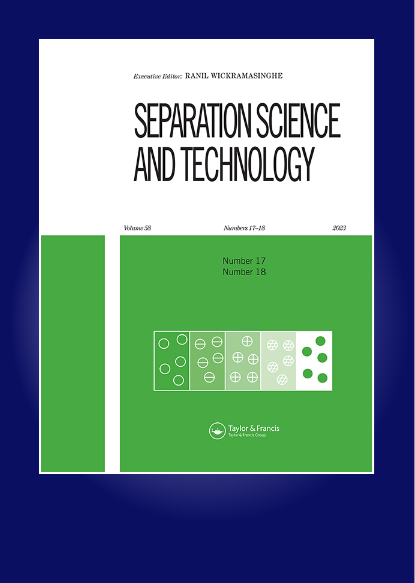了解三、四、六价官能团在金属-有机骨架(MOF) ZIF-67上的吸附行为:实验和理论研究
IF 2.3
4区 工程技术
Q3 CHEMISTRY, MULTIDISCIPLINARY
引用次数: 0
摘要
摘要金属有机骨架(MOFs)是一类具有不同结构拓扑、孔隙度和模块化的现代技术重要性的化合物。合成的ZIF-67对不同氧化态(UO22+、Th4+和Eu3+)的pH水溶液的吸附效率表现为:KdTh(6.19 × 103) > KdU (5.20 × 103) > KdEu (1.58 × 103)。Langmuir等温线对U、Th和Eu的吸附量分别为85.9 mg g−1、137.4 mg g−1和50.6 mg g−1。k2U ~0.089 g mg−1 min−1,k2Th ~0.011 g mg−1 min−1,k2Eu ~0.04 g mg−1 min−1。从负ΔG值可以看出,这些过程是自发的;和吸热性质(ΔHU ~10.5 kJ mol−1;ΔHTh ~12.8 kJ mol−1;ΔHEu ~8.3 kJ mol−1)。由于水分子的释放,吸附的熵值增加,表明吸附是通过形成内球络合物进行的。密度泛函理论(DFT)利用结合能预测的选择性(ZIF-67-Eu3+ ~ -60.90 eV, ZIF-67-Th4+ ~ -70.78 eV, ZIF-67-Th4+ ~ -69.52 eV)符合Th4+ > UO22+ > Eu3+的实验选择性。为了了解ZIF-67与阳离子之间的相互作用,估计了总态密度(TODS)和投影态密度(PODS)。作者要感谢Dr. P. K. Mohapatra, BARC, RC & I组副主任,放射化学部主任。披露声明作者未报告潜在的利益冲突。新型金属-有机骨架合成了金属-有机骨架(MOF) ZIF-67,用于从pH水溶液中高效萃取不同氧化态的f-阳离子(UO22+、Th4+和Eu3+),其吸附效率根据其化学势表现为:KdTh (6.19 × 103) > KdU (5.20 × 103) > KdEu (1.58 × 103)。Langmuir等温线对U、Th和Eu的吸附量分别为85.9 mg g−1、137.4 mg g−1和50.6 mg g−1。k2U ~0.089 g mg−1 min−1,k2Th ~0.011 g mg−1 min−1,k2Eu ~0.04 g mg−1 min−1。从负ΔG值可以看出,该过程是自发的,本质上是吸热的(ΔHU ~10.5 kJ mol−1;ΔHTh ~12.8 kJ mol−1 ΔHEu ~8.3 kJ mol−1)。由于水分子的释放,吸附的熵值增加,表明吸附是通过形成内球络合物进行的。密度泛函理论(DFT)用B.E.预测的选择性(ZIF-67-Eu3+ ~−60.90 eV, ZIF-67-Th4+ ~−70.78 eV, ZIF-67-Th4+ ~−69.52 eV)符合Th4+ > UO22+ > Eu3+的实验选择性。为了了解ZIF-67与f-阳离子之间的相互作用,我们估计了总态密度(TODS)和投射态密度(PODS)。本文章由计算机程序翻译,如有差异,请以英文原文为准。
Understanding the sorption behavior of tri, tetra and hexavalent f cations on metal–organic framework (MOF), ZIF-67: experimental and theoretical investigation
ABSTRACTMetal–organic frameworks (MOFs) are a class of compounds with modern-age technological importance due to diverse structural topologies, porosity, and modularity. ZIF-67 has been synthesized for efficient extraction of f cations in different oxidation states (UO22+, Th4+ and Eu3+) from aqueous pH medium exhibiting the trend in sorption efficiency as: KdTh(6.19 × 103) > KdU (5.20 × 103) > KdEu (1.58 × 103) in accordance to their chemical potential. Langmuir isotherm was found to be predominate with sorption capacity 85.9 mg g−1, 137.4 mg g−1 and 50.6 mg g−1 for U, Th and Eu, respectively. The sorption predominantly proceeded via pseudo 2nd order rate kinetics with rate constants: k2U ~0.089 g mg−1 min−1, k2Th ~0.011 g mg−1 min−1 and k2Eu ~0.04 g mg−1 min−1. The processes were found to be spontaneous as revealed from negative ΔG values; and endothermic in nature (ΔHU ~10.5 kJ mol−1; ΔHTh ~12.8 kJ mol−1; ΔHEu ~8.3 kJ mol−1). The sorption proceeded via the formation of an inner sphere complex as indicated from their enhancement in the entropy values on sorption due to the release of water molecules. The Density Functional Theory (DFT) predicted selectivity using binding energy (ZIF-67-Eu3+ ~ -60.90 eV, ZIF-67-Th4+ ~ -70.78 eV, ZIF-67-Th4+ ~ -69.52 eV) is in line with the experimental selectivity of Th4+ > UO22+ > Eu3+. Total density of states (TODS) and Projected density of States (PODS) were estimated in order to understand the interaction between the ZIF-67 and f cations.KEYWORDS: ZIF-67f-cationssorptionisothermradiolytic stability AcknowledgmentsThe authors wish to acknowledge Dr. P. K. Mohapatra, Associate Director, RC & I Group, BARC & Head, Radiochemistry Division.Disclosure statementNo potential conflict of interest was reported by the author(s).Metal-Organic Framework noveltyMetal-Organic Framework (MOF), ZIF-67 has been synthesized for efficient extraction of f-cations in different oxidation states (UO22+, Th4+ and Eu3+) from aqueous pH medium exhibiting the trend in sorption efficiency as: KdTh (6.19 × 103) > KdU (5.20 × 103) > KdEu (1.58 × 103) in accordance to their chemical potential. Langmuir isotherm was found to be predominate with sorption capacity 85.9 mg g−1, 137.4 mg g−1 and 50.6 mg g−1 for U, Th and Eu, respectively. The sorption predominantly proceeded via pseudo 2nd order rate kinetics with rate constants: k2U ~0.089 g mg−1 min−1, k2Th ~0.011 g mg−1 min−1 and k2Eu ~0.04 g mg−1 min−1. The processes were found to be spontaneous as revealed from negative ΔG values, and endothermic in nature (ΔHU ~10.5 kJ mol−1; ΔHTh ~12.8 kJ mol−1 ΔHEu ~8.3 kJ mol−1). The sorption proceeded via the formation of an inner sphere complex as indicated from their enhancement in the entropy values on sorption due to the release of water molecules. The Density Functional Theory (DFT) predicted selectivity using B.E. (ZIF-67-Eu3+ ~ −60.90 eV, ZIF-67-Th4+ ~ −70.78 eV, ZIF-67-Th4+ ~ −69.52 eV) is in line with the experimental selectivity of Th4+ > UO22+ > Eu3+. Total density of states (TODS) and Projected density of states (PODS) were estimated in order to understand the interaction between the ZIF-67 and f-cations.
求助全文
通过发布文献求助,成功后即可免费获取论文全文。
去求助
来源期刊

Separation Science and Technology
工程技术-工程:化工
CiteScore
6.10
自引率
3.60%
发文量
131
审稿时长
5.7 months
期刊介绍:
This international journal deals with fundamental and applied aspects of separation processes related to a number of fields. A wide range of topics are covered in the journal including adsorption, membranes, extraction, distillation, absorption, centrifugation, crystallization, precipitation, reactive separations, hybrid processes, continuous separations, carbon capture, flocculation and magnetic separations. The journal focuses on state of the art preparative separations and theoretical contributions to the field of separation science. Applications include environmental, energy, water, and biotechnology. The journal does not publish analytical separation papers unless they contain new fundamental contributions to the field of separation science.
 求助内容:
求助内容: 应助结果提醒方式:
应助结果提醒方式:


